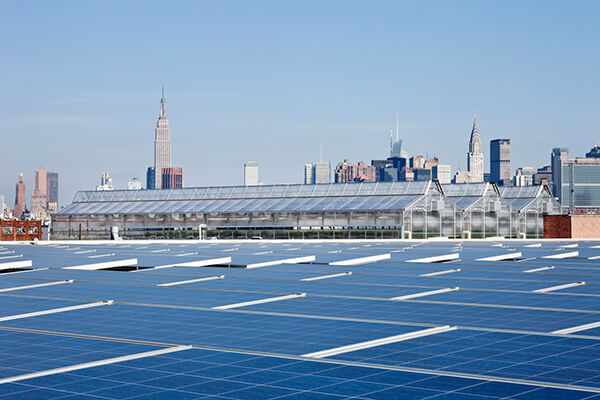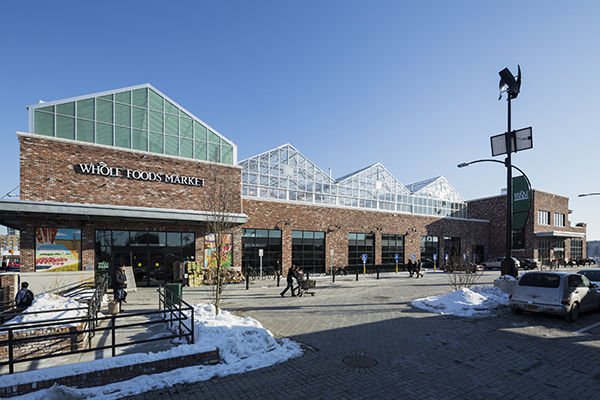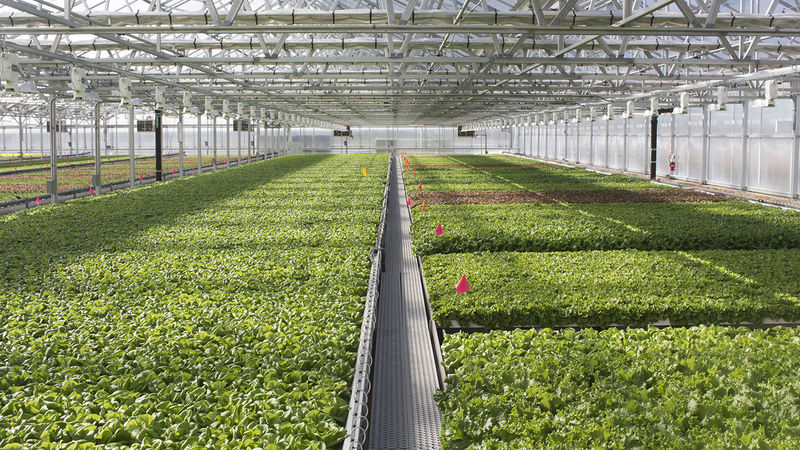It’s likely that the customers who shop at the Whole Foods at 214 Third Street in Brooklyn have no idea the lettuce they’re shopping for is grown directly over their heads.
The greenhouses are visible from the parking lot, where a sign proclaims: Look up, there is a greenhouse farm on our roof — but who reads signs in New York City? Inside the store, on the second floor, a set of locked glass doors leads to this rooftop farm. The doors are next to a small food court, and on a recent weekday afternoon the tables are busy with shoppers noshing from the salad bar or drinking coffee purchased from a nearby counter.

No one appeared to be looking out the window on a cold, January afternoon at the greenhouses sharing the roof. If they had, they would see the office of Gotham Greens, one of the nation’s leaders in urban farming.
Co-founded by Eric Haley ’07MBA in 2009, Gotham Greens today consists of 170,000 square feet of greenhouse space. The company built its first greenhouse in Brooklyn in 2011, and the firm now owns four: three in New York and one in Chicago. Each greenhouse was bigger than the last, and each saw innovations in automation and other improvements.
Gotham Greens is not alone in its urban-farmer business model. But while some other companies have scaled back or given up on rooftop greenhouse efforts, Gotham is thriving. Using a hydroponic system, the company grows 14 varieties of produce in its greenhouses — including lettuces, mustard greens, basil, kale, tomatoes — four acres in total. At the Whole Foods in Brooklyn, Gotham Greens products take up two whole cooler sections.
It’s all being managed from this tiny rooftop space, which Haley and co-founder Viraj Puri call headquarters. Here, the two are leading a charge to do nothing less than change the way city dwellers get their produce.
Haley, Gotham Greens’ chief financial officer, and Puri, its chief executive officer, met on an exchange trip to Italy. At the time, Haley was a student at the University of Wyoming and Puri attended Colgate University. Haley showed up in Italy with his arm in a sling — a torn shoulder muscle from a football-related injury — and his new roommate was wearing a Chicago Bears hat. They bonded over NFL games and sampling Italian cuisine. During the semester, they traveled together throughout Europe.
In 2006, Haley came to Notre Dame to study finance and entrepreneurship at the Mendoza College of Business. During his time there, the Denver, Colorado, native wrote up a business plan for the upscale ski town of Vail, Colorado, to create a community that would use solar panels and rain catchment to reduce its carbon footprint. The plan won third place in the school’s McCloskey Business Plan Competition.

After Notre Dame, Haley began working in finance in New York. He also rekindled his friendship with Puri. “I always had a huge passion for food,” Haley, 36, says. “That’s where our common interests align. I was really big into cooking, big into sourcing local ingredients. Big about restaurants and different culinary art experiences.”
Puri, who grew up in the Midwest, already had a history of sustainable projects under his belt. A passionate traveler and mountaineer, Puri worked on sustainability projects in such far-flung places as Malawi, Africa, where he spent a year, and a town called Leh in the Indian Himalayan region of Ladakh. Working in this high-altitude area near the border of Tibet, Puri and a nongovernmental organization developed a business that taught solar-power installation and green building skills. In four years, the company created more than 150 construction jobs and developed six green buildings.
“I knew I wanted to be less of a scientist and more of an implementer of sustainable technologies,” says the 35-year-old. “It was a great opportunity to work in the field and get my hands dirty.”
In 2007, Puri was working on the New York Science Barge, then docked on Manhattan’s West Side. The barge, later moved to Yonkers, has a 1,300-square-foot greenhouse along with solar and wind power, and is used to teach about sustainability. One evening Haley came by the floating greenhouse to take a look. Over a drink, he and Puri talked about starting a business that would grow produce in the city.
The pair spent nights and weekends the following year interviewing chefs, visiting large-scale produce and farmers markets, and talking with greenhouse experts to see if it was possible to do hydroponic greenhouse farming on a commercial scale.
- Related articles
- Home Grown
- Sustainability, Stewardship and Hands-on Horticulture
- Food, Farms and Family
- Part-time Bee Tender
“We started researching where food comes from,” Haley recalls. “Where do restaurants get high-end, highly perishable products?”
From a long way away, it turns out — places such as California and Arizona, Mexico and Israel, except for three or four months in summer and early fall. For most of the year, produce in New York is at least a week out of the ground and has changed hands multiple times by the time it’s on store shelves.
What if, instead, restaurants could purchase the greens grown locally? A head of lettuce could be harvested in the morning and be ready to eat that very night. Along with offering improved freshness, the idea is the essence of the farm-to-table movement — eating locally grown food to break the environmentally unfriendly practice of large-scale farming. Puri calls it “converting food miles into food footsteps.”
The pair contemplated growing on vacant land, but that idea was quickly ruled out. “We couldn’t find any arable land in Manhattan,” Haley says. “But rooftops are an underutilized asset class in New York.”
The two developed a business plan, subsequently winning the grand prize in the 2009 New York’s Green Business Competition and being awarded a $400,000 clean energy grant from New York State. They also raised about $1 million through friends, family and other investors. Eventually, they recruited their third partner — Jennifer Nelkin Frymark, now the company’s chief agriculture officer. She would provide the invaluable third link to Puri’s passion for sustainability and Haley’s financial know-how.
“All three of us have unique skill sets from what we went to school for and had our professional careers in,” Haley says. “It’s a pretty distinct division of responsibilities.”
Trained at the University of Arizona in plant sciences, Nelkin Frymark is an expert on everything from greenhouse design to plant nutrition, pest management and environmental sensors. She worked for NASA to develop a greenhouse that could work on Mars and also managed greenhouses at the National Science Foundation’s McMurdo and South Pole stations in Antarctica. Puri knew her from her work on the Science Barge.
She was also an expert in hydroponics. Modern use of this growing technique traces back to William Frederick Gericke of the University of California at Berkeley. Gericke, author of the 1940 book The Complete Guide to Soilless Gardening, reportedly grew tomato vines 25 feet high in his backyard using a mineral nutrient solution instead of soil.
The biggest benefit to hydroponics, of course, is that the method can be used to grow plants in a place where rich soil doesn’t exist — such as a rooftop. And thanks to modern technology, the system can grow plants far more efficiently than in the ground.
In 2010, the Gotham partners found a building owner in Queens willing to lease a roof. They began working their way through NYC’s byzantine building approval process and dealing with such difficulties as getting people to understand how hydroponics worked. One insurance agent, when he heard about their project, first envisioned an entire roof covered with a foot of water, like a giant bathtub. “No one had done it before. It was a unique experience,” Haley says.
To go inside one of Gotham Greens’ sterile greenhouses, you put on a hairnet (and, for those male Brooklyn hipsters, beard nets) and bathe the bottom of your shoes in a cleansing solution. Sick people are not allowed. Once through the door, you’ve entered the subtropics, where the air is a constant 75 degrees and the atmosphere is moist and thick with the smell of growing things.
Most of the greenhouse is taken up by rows and rows of white, gutter-like troughs. At plantings, seeds are placed in a small tower made up of volcanic rock, which absorbs water and quickly turns green with harmless algae. After the seedlings grow, they are transferred into the troughs, through which the company recirculates water saturated with a specialized mineral content. Sensors and other technology measure the air’s carbon dioxide and oxygen content, ambient temperature, light, humidity level and other variables. A computer controls everything. Glass can be shaded on hot days; overhead lights can be turned on at night or for overcast days; hatches can be opened in the glass roof to vent.
The half-acre of greenhouses above Whole Foods produces the equivalent of what can be grown on a 10-acre conventional farm and puts out 26 harvests a year, the Gotham owners say. Their other greenhouses are even more efficient.

Instead of using pesticides, workers use a device that looks like a blow dryer to release predatory insects — ladybugs and wasps — to keep flies, aphids and other pests to a minimum. “They’re among our most valuable and prized team members,” Puri says.
Staff members, some in Gotham Greens “Keep calm and farm on (a roof)” T-shirts, collect the produce daily. Plants harvested in the morning could be in a salad that very night, an especially appealing factor for customers like Jenny Jones, purchasing manager for two restaurants at the Whitney Museum that specialize in locally grown food.
“If your restaurant wants to focus on sustainable food, we have three to four months of the year if you want to serve green food [from conventional farms],” she says. “We want green food on the plate, and Gotham Greens presents something unique and exciting.”
Her executive chef was particularly enamored with Gotham’s bok choy. Because it’s grown in water instead of dirt, the restaurant can serve the entire plant instead of just the leaves, she says. Jones also recalls a visiting chef who sampled a dish wrapped in Gotham Greens butterhead lettuce and asked where the “perfect” vegetables came from.
“Hydroponic greens are more delicate,” she says. “They lead a beautiful, pampered life.”
Gotham opened its first greenhouse in 2011 — a 15,000-square-foot space on the roof of the Greenpoint Manufacturing and Design Center, a sort of manufacturing incubator built in a disused industrial space in Brooklyn. The founders’ year of research had put them in touch with a stable of interested customers, including Whole Foods and several Michelin Star restaurants, and within several months the greenhouse couldn’t grow enough to meet demand.
“We were turning away customers,” Haley says. “That was the ah-ha moment that this was more than just a prototype project. That’s when we started to pursue multiple building.”
Soon after, Whole Foods approached Gotham about partnering on the company’s new store in Brooklyn. The building was constructed with Gotham’s greenhouses in mind. When it opened in late 2013, Gotham had a new headquarters.
“We’ve been very diligent in our design,” Haley says. “Jenn knows how to design a building. We’ve continued to fine-tune those nutrient recipes, the feed varieties, the climate recipes, the lighting plan. We continue to do R&D and product development across the board.”
The firm’s third greenhouse, in Queens, opened in 2015. Located atop the Ideal Toy Factory, best known for creating and marketing the teddy bear and the Rubik’s Cube, the 60,000-square-foot greenhouse included automation that increased efficiencies and reduced the number of employees per square foot when compared to their earlier greenhouses.
At that point, Gotham was ready to expand to other cities. “Chicago was high on our list,” Haley says, because the three executives all have connections in the area.
Gotham was in the process of seeking a site for a greenhouse when the answer came to them. Method Products, a manufacturer of environmentally friendly cleaning supplies, was looking to build a rooftop greenhouse for its factory. The site was already generating wind power from a turbine installation, and the building had received LEED-Platinum certification, the highest level of energy efficiency certification available from the U.S. Green Building Council.
It was a fortuitous connection. Gotham built a 75,000-square-foot facility — almost two acres — with even more high-tech automation. The project is located in Chicago’s Pullman neighborhood, named for the famed rail cars that were once manufactured there. The greenhouse is said to be the world’s largest rooftop farm; it grows up to 10 million heads of leafy greens and herbs annually.
Meanwhile, the company continues to innovate. They’ve recently launched a new product meant to cut down on food waste. Acknowledging that half the nation’s food is thrown away, mostly due to cosmetic imperfections or supply-chain issues, the company now bags its slightly bruised and blemished products and sells them at a discount under the name Ugly Greens.
The firm is also involved with social outreach. Last year, Gotham Greens donated 40,000 seedlings to local schools and community gardens in New York and Chicago, and 30,000 pounds of produce to the NYC City Harvest and Greater Chicago Food Depository for distribution to needy clients.
Gotham Greens does face increased competition in the urban farming sector, as the idea grows in popularity. However, last year The Wall Street Journal reported that some urban farm businesses were pulling back on city rooftop designs because of high costs or permit issues, switching to less-expensive greenhouses in the suburbs.
Haley says Gotham isn’t concerned with competition. Gotham officials are in talks with building owners in other cities — they won’t discuss where — and Haley expects the company to double again, to more than 300 employees, in the next two to three years.
“We try to worry about ourselves,” he says, “one project at a time.”
Alan Wechsler, a freelance writer based in Albany, New York, has written for The New York Times, The Wall Street Journal and other publications.
